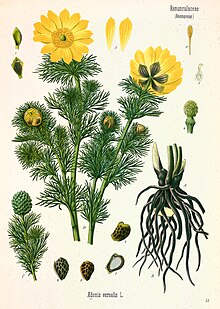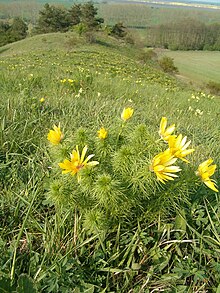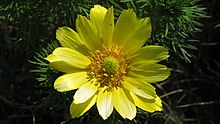Spring Adonis
| Spring Adonis | ||||||||||||
|---|---|---|---|---|---|---|---|---|---|---|---|---|

Spring Adonis ( Adonis vernalis ) |
||||||||||||
| Systematics | ||||||||||||
|
||||||||||||
| Scientific name | ||||||||||||
| Adonis vernalis | ||||||||||||
| L. |
The spring adonis or spring adonis ( Adonis vernalis ) is a species of the genus of the adonis ( Adonis ) in the buttercup family (Ranunculaceae). As an early bloomer, it develops its striking yellow flowers as early as April. In Central Europe the species is endangered and is under nature protection.
Description and ecology

General characteristics and leaves
The spring Adonis is a perennial herbaceous plant that reaches heights of 10 to 40, rarely up to 60 centimeters. A strong rhizome serves as a storage organ , from which numerous shoots arise to shoot. As is typical of a hemicryptophyte , the survival buds are located on the herbaceous shoot axis near the surface of the earth and are protected by the mulch or dead leaves. The root system is richly branched and reaches up to 1 meter deep. The vegetative reproduction is ensured by the rhizome.
The mostly unbranched stems grow upright. The almost sessile leaves are arranged alternately on the stem axis. They are one to four times pinnate (= finely pinnate ). the individual light green leaflets have a linear shape.
Flowering and flowering ecology
A wreath of pinnate leaves is located just below each flower. The terminal single flowers measure 4 to 8 centimeters in diameter. The flowering is initiated by five broad, egg-shaped, softly hairy, brownish sepals . They lie close to the spirally arranged petals . The ten to twenty free petals are narrow-wedge-shaped, 20 to 40 millimeters long and have a bright (light) yellow color. This coloring is caused by flavone glycosides . Numerous yellow stamens line the existing also in many unfused carpels , botanically known as chorikarpes Gynoceum referred.
When the sun is shining, the flowers open, expand their bracts and face the sun. From an ecological point of view, these are female disc flowers that have a high supply of pollen for pollinators. Nectar is not produced. Typical pollinators are pollen-collecting bees and pollen-eating flies.
Fruit and dispersal ecology
After successful fertilization , the numerous carpels develop into nuts , which are located close to the now elongated flower axis and are collectively referred to as the common nut fruit . The egg-shaped nuts contained in the spherical collective fruit are about 5 millimeters long. They are scattered with short white hairs. The exocarp has a network-nerved structure. At the tip is the remnant of the stylus in the form of a hook-shaped beak. At the base of the fruit, the exocarp consists of cells containing nutrients, the elaiosome .
The light brown nuts, which dry out when ripe, fall off the flower axis individually. Ants attracted by the elaiosome take over the further spread ( myrmecochory ).
The number of chromosomes is 2n = 16.
Occurrence and endangerment
The spring Adonis flower originally comes from Siberia and the Altai . It can also be found on dry and steppe grasslands as well as in pine forests in Europe and western Siberia . The area center is West Asian-South Siberian-Pontic-Pannonian .
The immigration of the spring Adonisröschen to Central Europe only took place at the end of the last Ice Age, the Vistula Ice Age . Through human activity, forest clearing and sheep breeding, new locations have been created for the spring Adonis. Scrub, reforestation and agriculture pushed this species back to its present day relic occurrences in Central Europe . All three of the last-mentioned factors continue to endanger these Central European locations, which would not be preserved without landscape conservation measures.


In Germany, the sophisticated spring Adonis flower occurs as a western outpost, especially in the new federal states; there in dry areas like in Brandenburg - although the spring Adonis is only ever widespread locally. There are some locations north of Frankfurt (Oder) , for example on the steep slope of the Oder near Lebus , the Priesterschlucht or on slopes near Mallnow . The largest contiguous area is found in the mountains between Carzig , Libbenichen and Dolgelin . In Dolgelin there is an annual guided hike to the Adonisröschen (usually on the 3rd Saturday in April).
To the west and north-west, the spring Adonisröschen occurs today in Germany only in separate small areas: Locations in the central German dry area, for example in the area of the Thuringian Drei Gleichen , northern Harz foreland, on the southern slope of the Kyffhauser , "chicken kitchen" (near Bebertal in Saxony-Anhalt), Weinberggrund near Hecklingen (in Saxony-Anhalt). But only very sporadically in the Rhine-Main dry area, for example on the Mainz sand or the Karlstadter dry grassland . There are only a few sites in Bavaria, for example Sulzheimer gypsum hills , Garchinger Heide and on Sodenberg
In Austria the spring Adonisröschen grows in the Pannonian area in the federal states of Vienna , Lower Austria and Burgenland . It occurs frequently to absent-mindedly, but its locations are rare. The main occurrences are dry and semi-arid grasslands; Secondary occurrences are perennial borders of dry and warm locations.
The spring Adonisröschen can generally be found in colline or montane altitudes ( Alps and low mountain ranges ). It thrives in dry meadows, light pine forests, sunny oak forests, loose downy oak forests, semi- arid grasslands or on warm, dry and bushy hills. The spring Adonis flower prefers dry, base and lime-rich, neutral, humus-rich and loose loam or loess soils .
The spring Adonisröschen is rated 3 (endangered) in Germany and Switzerland. In Austria it is considered endangered and is under full legal protection of nature. It is highly endangered in Bavaria (degree of risk 2).
Adonis vernalis has been listed at CITES in Appendix II since August 16, 2000 . This means that international trade in the plant, which takes place primarily as a drug for medicinal purposes, is not generally prohibited, but requires a permit issued by the exporting country.
Buildings, conversion of grassland into arable land, mining and excavation, covering and filling, private and scientific collectors, encroachment of grasslands are considered to be the causes of danger.
Plant sociology
It is a characteristic of the plant-sociological association Adonisröschen- Fieder-Zwenken -Rasen ( Adonido-Brachypodietum ) Krausch 1959. Another association, the Adonisröschen-Hem ( Adonido-Peucedanetum cervariae , also called Adonido-Thalictretum minus ), from the association of thermopile hemophiliacs ( Geranion sanguinei ) was described by Passarge in 1979. The association occurs in the area of the middle Oder . It is believed that it also occurs in Poland. In addition to the spring Adonisröschen, typical species are the small meadow rue , which also gives it its name , as well as small meadowsweet , horned speedwell , common oat , dyer's Meier , medium flax leaf , medium plantain and steppe fennel . The company settles flat Mull-Pararendzinen with a pH value between 6.9 and 7.1 on moraines of the Vistula Ice Age . Locations are the south side of slopes that have a medium to steep slope. They are located in the subcontinental climatic area, which is characterized by an average rainfall of 480 to 520 mm per year.
Taxonomy
The first description of Adonis vernalis was in 1753 by Carl von Linné in Species Plantarum , Volume 1, pp. 547-548. A homonym is Adonis vernalis Asso (published in Syn. Stirp. Aragon. 1779, p. 70). A synonym for Adonis vernalis L. is Adonanthe vernalis Spach . The specific epithet vernalis means "spring blooming" and it is derived from the Latin word ver for spring.
Origin of names and other common names
The genus name Adonis is derived from the blood-red blooming species. According to Greek mythology, Aphrodite transformed her darling Adonis , who was killed by a boar sent by the jealous Ares, into the blood-red flower. Hence the name Adonisröschen for the yellow-blooming spring Adonisröschen can only be understood if one knows that there are also red-blooming species, see genus Adonisröschen .
In addition, the following common names are or were used, sometimes only regionally : Christwurz, Bohemian Christwurz ( Silesia ), Black Niesswurz, Devil's Eyes ( Mark Brandenburg , Silesia ), Goat Flower (Mark near Küstrin ), Lieberlei.
use
Occasionally the spring Adonis is used as an ornamental plant in gardens of the temperate latitudes. Barlage's Big Book of Garden Flowers recommends Adonisröschen for wild and romantic spring gardens, preferably with stones and pieces of rock. Compared to Adonis amurensis , Adonis vernalis prefers more permeable soils and tolerates summer drought better. Waterlogging and snails are harmful. You need twelve plants per square meter. Lucky cases are pale yellow and double-blooming selections that are not named in the trade. Cultivated plants do not fall under the provisions of CITES in Appendix II.
The municipality of Bollstedt has it in the local coat of arms.
Medical significance and ingredients
The Russian physician NO Bubnoff first introduced the plant into modern official medicine in 1879. He used extracts of the plant as a heart stimulating agent. This justified the interest in further research into the ingredients of Adonis vernalis. Ahead of particular use in edema is within the population of the former Soviet Union by the authors Shang et al. highlighted.
The dried aboveground parts of the flowering plant are used as medicinal drugs (Adonidis herba, Herba Adonidis, Herba Adonidis vernalis). They contain about 30 cardenolide glycosides , especially adonitoxin (adonitoxigenin) and cymarin . Other ingredients are flavonoids such as Adonivernith.
As with all plant species with cardiac glycosides , the toxic and therapeutically effective dose are also close together. Therefore, only the drug that has been adjusted to a certain active value is used in order to avoid overdosing or underdosing. Extracts from this “discontinued Adonis powder” were used in combination preparations that also contained lily of the valley , sea onion or oleander extracts for mild cases of cardiac insufficiency and nervous heart problems with a feeling of restlessness. The effect of the heart-active glycosides of the Adonis herb ( Herba Adonidis vernalis ) sets in faster, but is weaker and less persistent than with the red foxglove . Diuretic and calming effects are described.
In 1988, Commission E of the former Federal Health Office saw an indication of Adonis' herb for mild heart failure and accompanying nervous symptoms. It is not recommended to use it because of the difficult dosage. The Homeopathy knows Adonis in heart failure with kidney problems, rheumatism, and overactive thyroid gland .
swell
- Manfred A. Fischer, Karl Oswald, Wolfgang Adler: Excursion flora for Austria, Liechtenstein and South Tyrol . 3rd, improved edition. State of Upper Austria, Biology Center of the Upper Austrian State Museums, Linz 2008, ISBN 978-3-85474-187-9 .
- Gerhard Madaus . Textbook of biological remedies. 4 volumes. Thieme, Leipzig 1938; Reprint Hildesheim 1976, Volume I, pp. 406–412 (digitized version )
- Adonis vernalis , homeopathic drug testing, Dr. BK Bose Foundation, 2003: full text. (PDF)
- Adonis vernalis L., Spring Adonis. In: FloraWeb.de.
- Adonis vernalis - Spring Adonis from WWF-Traffik . (PDF; 113 kB)
- Dagmar Lange: Conservation and Sustainable Use of Adonis vernalis, a Medicinal Plant in International Trade. In: Plant species conservation monographs 1. Landwirtschaftsverlag, Münster-Hiltrup, 2000.
Individual evidence
- ↑ a b c d e box Lüttig: Rosehip & Co - flowers, fruits and spread of European plants. Fauna Verlag 2003, ISBN 3-935980-90-6 , p. 242 f.
- ↑ a b Spring Adonis Beauty . In: BiolFlor, the database of biological-ecological characteristics of the flora of Germany.
- ^ Helga Dietrich, Wolfgang Heinrich: Frühblüher um Jena. EchinoMedia Verlag, 2008, ISBN 978-3-937107-15-8 , p. 159 ff.
- ^ Erich Oberdorfer : Plant-sociological excursion flora for Germany and neighboring areas. 8th edition. Verlag Eugen Ulmer, Stuttgart 2001, ISBN 3-8001-3131-5 , p. 421.
- ↑ a b c Norbert Wedl: NSG Mallnower Oderhangs: Spring Adonis in Steppenrasen , published by NABU.
- ↑ Or attachments at Lebus at Natura2000 .
- ↑ Priest Gorge at Natura2000 .
- ↑ Hang near Mallnow at Natura2000 .
- ↑ Project area 10: Drei Gleichen (FFH area 5131-303)
- ↑ Kyffhaeuser Nature Park. ( Memento from May 20, 2014 in the Internet Archive ) (PDF; 1.2 MB)
- ↑ Chicken kitchen. (PDF; 2.3 MB), pp. 17–18.
- ↑ Weinberggrund near Hecklingen . (PDF; 4 MB).
- ^ Mainzer Sand - natural event in the Rhine-Main conurbation .
- ↑ Franz-G. Dark: The Karlstadt dry grassland. A plant guide to internationally significant grasslands. Brochure, published by the government of Lower Franconia, March 2003. 23 pages.
- ↑ Entry at Blumeninschwaben .
- ↑ Spring bloomers on the Sodenberg.
- ↑ Oskar Sebald et al.: The fern and flowering plants of Baden-Württemberg. Ulm 1993, Volume I, p. 265: “ Adonis vernalis L. The predominantly Eastern European widespread species comes close to Baden-Württemberg in some places (Mainz, main area near Karlstadt and southern Alsace). "
- ↑ a b Appendix 2: How to implement sustainability: The role of CITES . In Uwe Schippmann, Danna J. Leaman, AB Cunningham: Impact of Cultivation and Gathering of Medicinal Plants on Biodiversity: Global Trends and Issues. FAO Food and Agriculture Organization of the United Nations, Rome 2002.
- ↑ a b Spring Adonis Beauty. In: FloraWeb.de.
- ↑ Heinrich E. Weber: Bushes, hedges, herb edges. Ulmer Verlag 2003, ISBN 3-8001-4163-9 , p. 183 ff.
- ↑ First publication scanned at biodiversitylibrary.org .
- ^ Adonis vernalis at Tropicos.org. Missouri Botanical Garden, St. Louis
- ↑ a b Gerhard Madaus : Textbook of biological remedies. 1938; Adonis vernalis - Devil's Eye - Ranunculaceae .
- ↑ Carl Jessen : The German folk names of plants. Publisher by Philipp Cohen Hannover 1882, p. 11.
- ↑ Hieronymus Brunschwig : Small distilling book . Strasbourg 1500, sheet 121r-v. (Digitized version)
- ^ Andreas Barlage, Frank M. von Berger: The great book of garden flowers. Over 2000 perennials, summer flowers, bulb plants and grasses. Ulmer, Stuttgart 2016, ISBN 978-3-8001-3394-9 , pp. 115–116.
- ↑ X. Shang, X. Miao F. Yang, C. Wang, B. Li, W. Wang, H. Pan, X. Guo, Y. Zhang, J. Zhang: The Genus Adonis as an Important Cardiac Folk Medicine: A Review of the Ethnobotany, Phytochemistry and Pharmacology. In: Frontiers Pharmacology. 10:25. 2019; doi: 10.3389 / fphar.2019.00025
- ^ Artur Burger, Helmut Wachter : Hunnius. Pharmaceutical Dictionary. Founded by Curt Hunnius, 6th, completely revised and greatly expanded edition. De Gruyter, Berlin / New York 1986, ISBN 3-11-007029-4 , p. 16.
- ↑ https://buecher.heilpflanze-welt.de/BGA-Kommission-E-Monographien/adonidis-herba-adoniskraut.htm Federal Gazette No. 85 of May 5, 1988, monograph by Commission E
- ↑ Heinz Schilcher (Ed.): Guide to Phytotherapy. 5th edition. Urban & Fischer, Munich 2016, ISBN 978-3-437-55344-8 , p. 46.
- ^ Ingrid and Peter Schönfelder : The new manual of medicinal plants , Franckh-Kosmos Verlagsgesellschaft, 2004, ISBN 3-440-09387-5 .
- ↑ King's American Dispensatory. 1898: Adonis - Pheasant's Eye .
- ↑ Georgos Vithoulkas: Homeopathic Medicines. Materia Medica Viva. Volume I. Elsevier, Munich 2009, ISBN 978-3-437-55061-4 , pp. 97-103.
Web links
- Adonis vernalis as a medicinal plant.
- On the toxicity of Adonis vernalis at giftpflanze.com.
- Profile and distribution map for Bavaria . In: Botanical Information Hub of Bavaria .
- Spring Adonis . In: BiolFlor, the database of biological-ecological characteristics of the flora of Germany.
- Adonis vernalis L. In: Info Flora , the national data and information center for Swiss flora . Retrieved October 21, 2015.
- Area map at Den virtuella floran.
